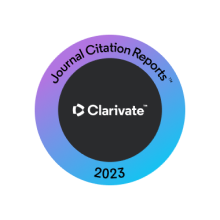Abstract
Background: The thrombosis of the stent is one of the most important complications of percutaneous interventions, resulting in complete occlusion of the stented vessel. Aim of this study was to determine the validity of Stent Thrombosis Risk Score (STRS) in predicting early stent thrombosis (ST) after primary Percutaneous Coronary Intervention (PCI)
Methods: For this study, 569 consecutive patients undergone primary PCI from July 2018 to December 2018 were recruited. Early ST was defined as ST occurred during or within 30 days after the procedure. The STRS was calculated as proposed, developed, and validated in a past study. The receiver operating characteristic curve analysis was performed to determine the optimal cut-off value and area under the curve (AUC).
Results: A total of 569 patients were included, the median age was 56 [61-50] years. Early ST was observed in 33 (5.8%) patients. The median STRS was 4 [5-3] vs. 3 [4-2]; p=0.009 for patients with and without Early ST respectively. STRS was found to be an independent predictor of early ST with an adjusted odds ratio of 1.41 (1.02-1.95). AUC was 0.631 and the optimal cut-off value was ≥ 5. Early ST rate was 3.3% at STRS of 0-2, which raised to 5.0% at STR of 3-4, and 17.2% at STRS of ≥ 5.
Conclusions: In conclusion, STRS was found to be an independent predictor of early ST after primary PCI and has significant discriminating power. The rate of early stent thrombosis after primary PCI exponentially increased at STRS cut-off value of ≥5.
Recommended Citation
Kumar, Rajesh; Tariq, Sahar; Fatima, Madiha; Saghir, Tahir; Batra, Mahesh Kumar; Karim, Musa; Sial, Jawaid Akbar; Khan, Naveedullah; and Rizvi, Syed Nadeem Hasan
(2020)
"Validity of the Stent Thrombosis Risk Score in Predicting Early Stent Thrombosis after Primary Percutaneous Coronary Intervention,"
Journal of the Saudi Heart Association: Vol. 32
:
Iss.
2
, Article 19.
Available at: https://doi.org/10.37616/2212-5043.1024
Creative Commons License

This work is licensed under a Creative Commons Attribution-Noncommercial-No Derivative Works 4.0 License.




